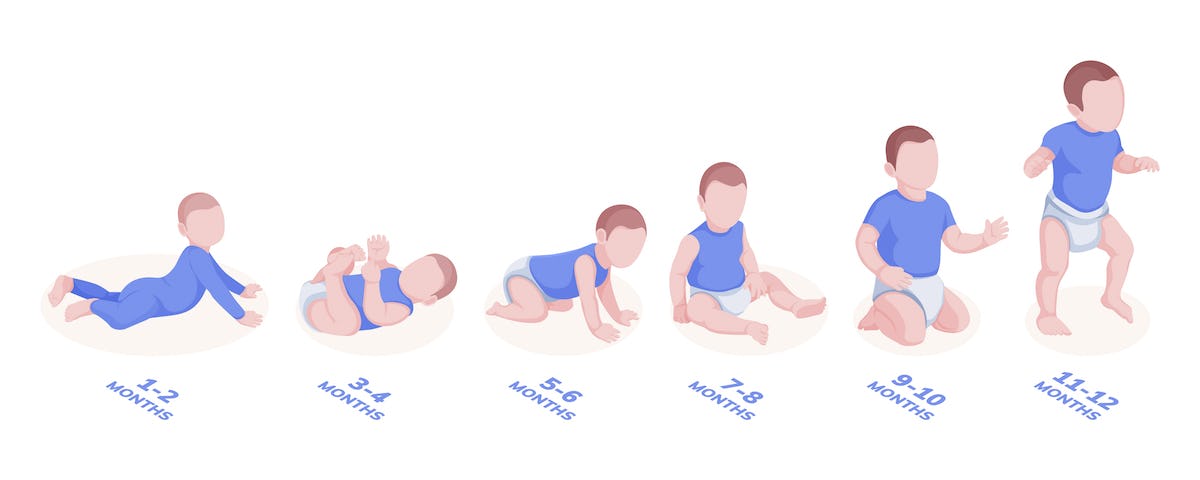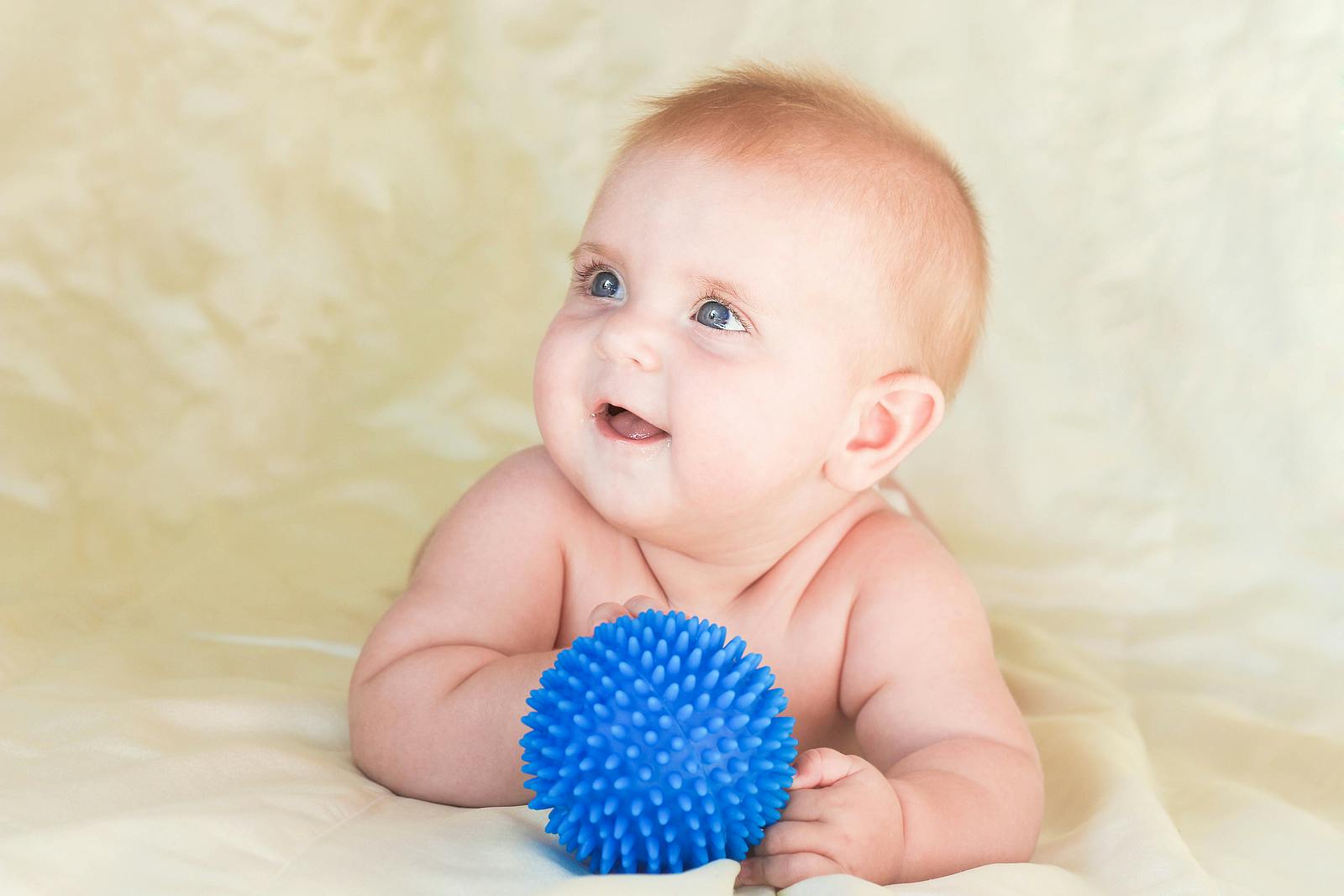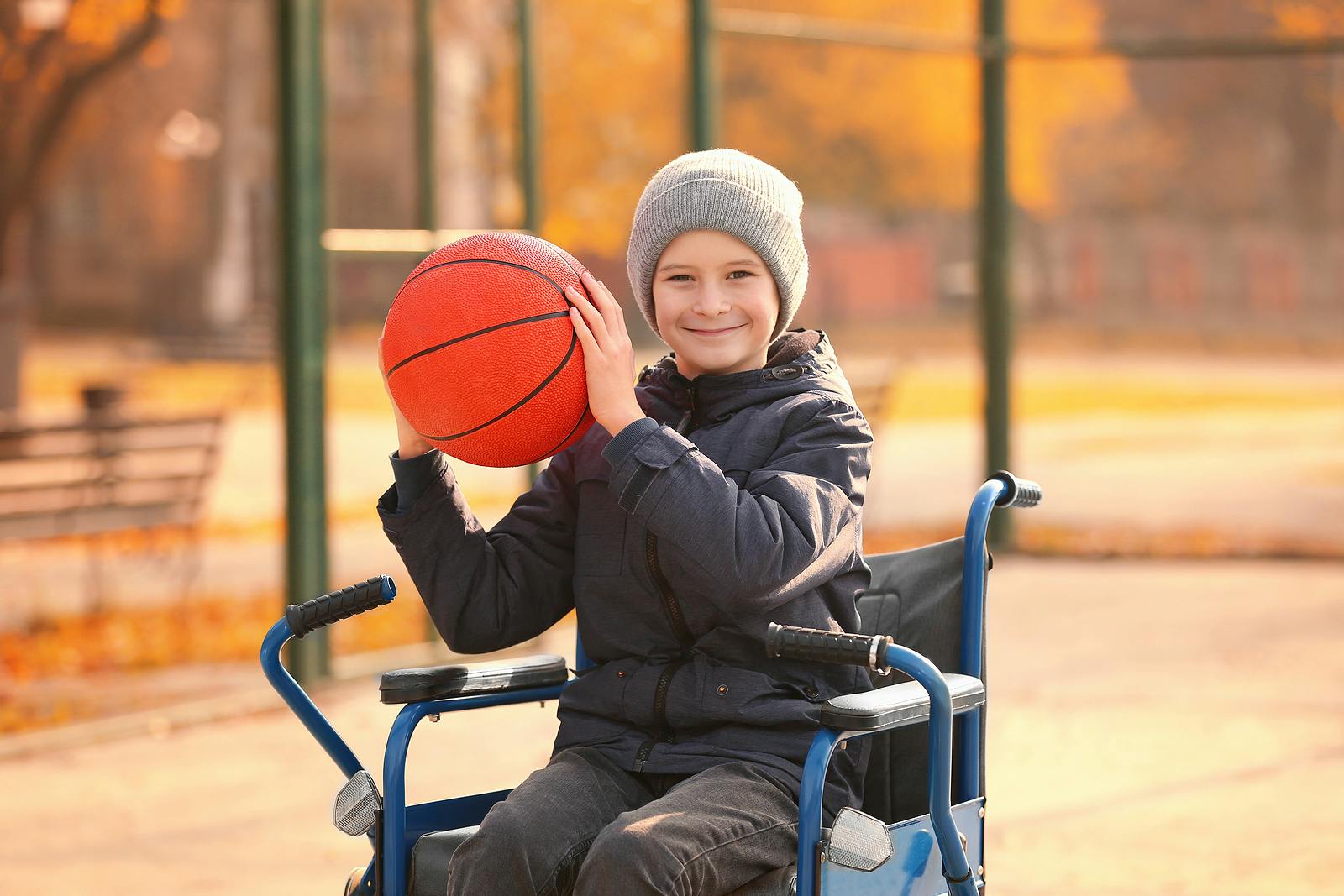At Back in Motion Physical Therapy, we treat infants, children, and teens with a wide range of pediatric conditions. We provide a safe, friendly, and supportive environment in which children, parents, and therapists work together to ensure optimal treatment that is tailored to your child.
Pediatric diagnoses we treat include:
- Torticollis
- Prematurity
- Gross motor delay
- Toe walking
- Gait dysfunction
- Hypotonicity, muscle weakness
- Cerebral palsy
- Spina bifida
- Osgood-Schlatter Disease
- Post-surgical therapy
- Orthopedic injuries
- Sports injuries
- Bedwetting, constipation, bowel and urine accidents and other pediatric pelvic health issues are treated at our partner practice, Physical Therapy Your Way, Advanced and Specialty Care.
Torticollis
Torticollis is an abnormal posturing of the head and neck that may affect your baby's development. Usually, torticollis results from positioning or crowding in utero that causes a baby's neck muscles to be short and tight on one side and elongated on the other.Torticollis is an abnormal posturing of the head and neck that may affect your baby’s development. Usually, torticollis results from positioning or crowding in utero that causes a baby’s neck muscles to be short and tight on one side and elongated on the other. More rarely, torticollis results from visual impairments that cause babies to always look one direction, trauma, or muscle masses. You may notice torticollis as soon as your baby is born, or it may develop 2 or more months after birth.
ability, and reflexes.
Signs of Torticollis
Parents whose babies tilt their heads toward one side, sleep with their heads always in the same position, or regularly look a certain direction should ask their pediatricians about torticollis.
Parents should also ask about torticollis if they notice their baby has an asymmetrical or flattened head shape. These abnormal head shapes are called plagiocephaly, and up to 90% of babies with torticollis also have plagiocephaly. Plagiocephaly and torticollis go hand-in-hand because an infant's soft skull may become flattened in areas subject to prolonged pressure, which is usually due to a baby's preferred sleeping position. Simultaneous specialized treatment of both conditions is required for the quickest and best results.
Torticollis and Physical Therapy
Pediatric physical therapists are experts at treating torticollis and plagiocephaly. In fact: "Infants participating in physical therapy demonstrate increased symmetry on average 2 months sooner compared to infants receiving stretching from parents only (Ohman et al, 2010)."
Pediatric physical therapists assess your baby’s posture, body strength and flexibility, spinal alignment, head and facial features, gross motor development, visual tracking
Treatment helps babies with torticollis maintain a midline head position at each stage of development to encourage symmetrical movements and bilateral achievement of motor milestones, like being able to look or roll to both sides.
Infants participating in PT demonstrate increased symmetry on average 2 months sooner compared to infants receiving stretching from parents only (Ohman et al, 2010).Physical therapy treatment is always tailored to your baby’s needs. It may include:
- Teaching you how to position your baby for sleeping, eating, feeding, and holding for optimal neck position
- Helping you increase your baby’s tummy time and decrease the time your baby spends in swings or car seats, to better strengthen neck muscles Stretching your baby’s neck and trunk
- Helping your baby with age-appropriate activities
- Referring for a cranial orthotic, if necessary, to treat plagiocephaly

Early Physical Therapy is Best!
"Strong evidence supports early intervention for the best outcomes in both torticollis and plagiocephaly" (Demirbilek, 1999). "Younger babies who are diagnosed and treated early have the best results in the least amount of time" (Kaplan et al, 2013).| AGE OF REFERRAL | LENGTHS OF SYMPTOMS/TREATMENT |
|---|---|
| <3 MONTHS | 1.5-3 MONTHS |
| >3 MONTHS | 3-6 MONTHS |
| >6 MONTHS | 9-10 MONTHS |
Early intervention is also effective in decreasing the chance your baby will experience a cascade of injuries associated with untreated torticollis and plagiocephaly. Due to poor neck and head position, babies with torticollis may face persistent gross developmental delays, facial asymmetry, injury to the nerves in the neck that control the arms, and jaw dysfunction. (Kaplan et al, 2013). Babies who always look to the right, for example, may learn to roll only to the right, may not learn to reach with their left hands, and may have less tolerance for tummy time, sitting, crawling, or any position that requires them to maintain a certain head position. Untreated plagiocephaly may cause facial abnormalities, asymmetric ear position, and a bulging forehead.
How to get Help
The pediatric physical therapists at Back in Motion love helping babies with torticollis and supporting their families. Whether you have a physical therapy prescription from your pediatrician or you simply suspect your baby has torticollis, schedule an appointment with one of our experts. We will evaluate your baby, begin treatment, and refer you to other care providers if needed. Call us at (703) 372-5716 to schedule an evaluation.
Physical therapy treatment is individualized for each child and may include any of the following:- Parent education - holding and carrying positions, sleep positions, play positions
- Tactile (touch) and kinesthetic (movement) stimulation
- Facilitation of age-appropriate developmental activities such as rolling, sitting, crawling, walking, jumping, hopping, and skipping
- Balance training
- Genu Valgum, often called knock knees and commonly associated with in-toeing. Should resolve by 7 years old.
- Gait training
- Functional strengthening activities through play
 If your child was born prematurely, see a Back in Motion pediatric physical therapist to help with optimal gross motor development. Call (703) 372-5716.
If your child was born prematurely, see a Back in Motion pediatric physical therapist to help with optimal gross motor development. Call (703) 372-5716.
Prematurity
Any infant born at 37 weeks or sooner is premature. One in 9 babies in the United States is born prematurely and prematurity is the number one cause of death in babies in the United States. Prematurity Babies born prematurely are at greater risk for health problems, lower birth weight, and developmental and movement disabilities.
Any infant born at 37 weeks or sooner is premature. One in 9 babies in the United States is born prematurely and prematurity is the number one cause of death in babies in the United States. Prematurity Babies born prematurely are at greater risk for health problems, lower birth weight, and developmental and movement disabilities. This is because babies born prematurely typically have lower muscle tone and may require longer hospital stays that require immobilization. These babies may have greater difficulty controlling their trunks, may have increased stiffness, or jerky arm and leg movements. Normal gross motor activities such as rolling, sitting, crawling, standing, walking, or jumping may be delayed.
How Physical Therapy can help: Research shows that early-intervention physical therapy for infants born prematurely is beneficial for motor development. PT for babies with prematurity begins in the Neonatal Intensive Care Unit (NICU) and may last several years.
Physical therapy treatment is individualized for each child and may include any of the following:
- Parent education - holding and carrying positions, sleep positions, play positions
- Tactile and kinesthetic stimulation
- Facilitation of age-appropriate developmental activities such as rolling, sitting, crawling, walking, jumping, hopping, and skipping
- Balance training
- Gait training
- Functional strengthening activities through play
If your child was born prematurely, see a Back in Motion pediatric physical therapist to help with optimal gross motor development. Call (703) 372-5716 to schedule your evaluation.
Gross Motor Delay
Gross motor activities require the use of large muscle groups such as the arms, legs, or trunk. Gross motor delay is an umbrella diagnosis for children who may not be rolling, sitting, crawling, walking, or performing other age-appropriate coordinated movements of their arms, legs, and trunk. When pediatricians ask parents if their baby or child is meeting developmental milestones, it is to check whether there is a delay.Gross motor activities require the use of large muscle groups such as the arms, legs, or trunk. Gross motor delay is an umbrella diagnosis for children who may not be rolling, sitting, crawling, walking, or performing other age-appropriate coordinated movements of their arms, legs, and trunk. When pediatricians ask parents if their baby or child is meeting developmental milestones, it is to check whether there is a delay. Although every child develops differently, there is an age range that is considered normal for acquisition of certain skills. For example, a baby can typically roll by 4-5 months, crawl at 9 months, and walk by 12-15 months old. Toddlers can usually kick a ball by 2 years and walk up and down stairs by age 3. Four year olds can usually hop, and 5 year olds can normally swing and climb. For a more complete list of motor, cognitive, and social/emotional milestones, please see the Centers for Disease Control and Prevention or the American Academy of Pediatrics.
There are a number of causes for gross motor delay. Some cases are mild and may resolve on their own. Others may require targeted therapy and may be a result of prematurity, Down's Syndrome, or another condition that is known at birth. Still other delays are early indicators of a possibly undiagnosed underlying issue such as thyroid dysregulation, autism spectrum disorder, or Duchane's muscular dystrophy. Most pediatricians recommend physical therapy as early as infancy to help babies and children with gross motor delays develop optimally.
 Physical Therapy for gross motor delays will consist of an individualized treatment that may include:
Physical Therapy for gross motor delays will consist of an individualized treatment that may include:
- Showing you how to help your child move better
- Teaching age-appropriate motor activities and exercises
- Training for gait and balance
- Functional strengthening
- Sensory integration exercises
- Manual cueing for appropriate muscle activity
- Facilitating efficient movement patterns
- Assessing progress toward goals
- Progressing an individualized home exercise program
- Communicating openly with your pediatrician and/or specialist

Toe Walking
Toe walking describes a pattern of gait in which children walk on the balls of their feet rather than initiating contact with their heels to the floor. Toe walking may be normal in children younger than age 2. By age 3, children should have developed a heel-to-toe walking pattern.Toe walking describes a pattern of gait in which children walk on the balls of their feet rather than initiating contact with their heels to the floor. Toe walking may be normal in children younger than age 2. By age 3, children should have developed a heel-to-toe walking pattern. Around the age of 5, children no longer consciously think about walking. Walking has become a movement plan that is stored in their brains. Once this motor plan has become stored in the subconscious, it is extremely difficult to change. For this reason, early intervention in toe walking is key.

Causes and Effects
Toe walking on its own is not usually a cause for concern and may be treated early with physical therapy to help avoid tight calf and ankle muscles and allow normal development of running and playing. Usually, toe walking is idiopathic, or for no known cause. Other times there is an underlying condition such as autism, ADHD, cerebral palsy, or muscular dystrophy. Idiopathic toe walking means the cause is unknown. Some potential contributors that may be treated specifically with physical therapy are shortening or chronic tightness of the Achilles tendon, sensory integration disorders, and difficulties with balance or coordination.
Physical Therapy
If your child walks on their toes, our pediatric physical therapists at Back in Motion, will thoroughly evaluate them. We will ask questions about in-utero growth, developmental milestones, medical history, and what goals you and your child have for therapy. We then thoroughly assess your child's muscle strength, joint movements, gait, balance, coordination, reflexes, and muscle tone. If we suspect an underlying condition, we will refer you to your pediatrician for diagnosis even as we begin to treat the toe walking. We will individualize treatment based on what your child needs. Treatment may include:
- Stretching and range of motion exercises
- Gait training using a variety of age-appropriate games and activities
- Balance training using engaging activities and performed on a variety of surfaces (stable, wobbly)
- Sensory integration exercises
- Parent training on how to best help your child walk in a heel-to-toe pattern
- Assistance with orthotics, if necessary

Gait Dysfunction
Gait is our walking pattern. Any deviation from normal walking can be considered a gait abnormality. Normal gait requires multiple body systems to function together. Normal gait requires core stability, leg strength, lower body range of motion, sensation, and coordination.Gait is our walking pattern. Any deviation from normal walking can be considered a gait abnormality. Normal gait requires multiple body systems to function together. Normal gait requires core stability, leg strength, lower body range of motion, sensation, and coordination.
Diseases or disorders that affect any of the systems involved in walking may lead to gait dysfunction. Potential causes of abnormal gait are injury, infection, stroke, arthritis, birth defect, neurological diagnosis, or vestibular dysfunction.

Toddlers usually begin walking between 12 and 14 months. These new walkers have gait characteristics that are normal in early childhood, but not normal later. If gait is atypical for a child’s age, is painful, appears asymmetrical or is present with other symptoms, you should consult with your pediatrician. Listed below are a few gait abnormalities, their descriptions, and their normal age range:
- Toe walking (please see Toe Walking section) - common up to 3 years old.
- In-toeing, often referred to as Pigeon toed - characterized as the knees and feet turning inward.This is most common between 3-8 years old.
- Metatarsus adductus - the foot appears to be in a "C shape." Usually resolves by the age of 6.
- Genu Varus, also known as bow legged, in which the knees appear to be bowing outward and may also be seen with out-toeing. This should be resolved by the age of 1.
- Genu Valgum, often called knock knees and commonly associated with in-toeing. Should resolve by 7 years old.
- Pes planus or flat feet is common because children have a flexible foot. The arch usually does not develop until 2-3 years old; therefore, this should be resolved by the age of 6.
- Crooked toes - usually correct with weightbearing.
Gait Dysfunction and Physical Therapy
Physical Therapy Evaluation may include: extensive history from parents, range of motion measurements, muscle strength measurements, gait analysis, balance tests, and coordination testing. Physical Therapy Treatment may include:
Physical Therapy Treatment may include:
- Stretching and strengthening - exercises are age appropriate and play integrated
- Balance Training - utilizing different surfaces
- Gait Training - tactile, visual, verbal feedback
- Assistive device and/or orthotic recommendations
There are several neurological diagnoses, underlying muscle weakness, joint stiffness, pain, asymmetry that can contribute to a gait impairment and can be treated successfully with skilled physical therapy. Back In Motion treats every patient holistically and develops personalized treatments based on diagnosis, evaluation findings, patient goals, and parent goals. Call us at (703) 372-5716 to schedule an evaluation.
Cerebral Palsy
Cerebral Palsy is a movement disorder usually diagnosed in early childhood. Cerebral Palsy affects brain development. ts many known causes and risk factors include infections to the pregnant mother or the infant, fetal stroke or bleeding in the developing brain, traumatic brain injury, and genetic mutations.Cerebral Palsy is a movement disorder usually diagnosed in early childhood. Cerebral Palsy affects brain development. ts many known causes and risk factors include infections to the pregnant mother or the infant, fetal stroke or bleeding in the developing brain, traumatic brain injury, and genetic mutations.
Signs and Symptoms
There are a variety of symptoms and a wide range in the severity of cerebral palsy. Some symptoms that can be addressed with physical therapy:
- Hemiparesis or muscle weakness on either side of the body
- Abnormal muscle tone such as hypertonicity (rigidity) or hypotonicity (floppiness)
- Poor balance
- Postural dysfunction
- Impaired muscle coordination
- Gait training
- Gross motor delays -- difficulty sitting, crawling, walking
Some other common signs and symptoms include difficulty swallowing, learning disabilities, tremors or writhing movements, seizures, hearing or vision problems.

Physical Therapy
Although cerebral palsy is not a progressive disorder, its effect on the musculoskeletal system can cause worsening symptoms if left untreated. Physical therapy stretching and range of motion exercises help prevent permanent limitations of joint mobility, called contractures, which may be caused by spastic muscles with increased muscle tone. Physical therapists help patients improve balance and coordination by providing individualized, age-appropriate training. Physical therapists also help with posture re-education, overall strengthening, and gait training to help people with cerebral palsy move more efficiently and with fewer aches and pains. Physical therapists also help people with cerebral palsy effectively use assistive devices such as orthotics, walkers, wheel chairs, and other devices needed for activities of daily living. At Back in Motion Physical Therapy, we work closely with speech therapists, occupational therapists, and physicians, for cohesive care of children with cerebral palsy. Call us at (703) 372-5716 to schedule your evaluation.

Spina Bifida
According to the Spina Bifida Association, spina bifida is a birth defect in which the neural tube that encases the spinal cord and brain does not close completely. The three common types of spina bifida vary in severity depending on the location and size of the opening in the neural tube.According to the Spina Bifida Association, spina bifida is a birth defect in which the neural tube that encases the spinal cord and brain does not close completely. The three common types of spina bifida vary in severity depending on the location and size of the opening in the neural tube.

Types of Spina Bifida:
- Spina Bifida Occulta - usually does not have any visible signs and typically does not damage the spinal cord or nerves. A small group of people with this type may have mild neurological symptoms or pain.
- Meningocele - part of the neural tube is pushed outside of the spinal column and creates a sac. This type may cause minor neurological harm.
- Spina Bifida Cystica- the most severe form; parts of the spinal cord and nerves remain open and may also increase the amount of fluid on the brain.
Symptoms of Spina Bifida:
Symptoms are dependent on the location of the defect and the severity of the condition. Most people with spina bifida occulta have no symptoms, while many with spina bifida cystica are partially or completely paralysed. Extent of paralysis is dependent on the location of the defect. A defect in the neck or cervical spine area will affect arms and legs and may require the use of a wheelchair. A defect in the lower part of the spine only affects the legs, not the arms.
Other signs and symptoms may include an abnormal tuft of hair or birthmark on the back over the defect, bowel and bladder dysfunction due to damage of the nerves responsible for these functions, difficulty moving particular parts of the body, muscle weakness, joint stiffness, and overactive reflexes.
Physical Therapy and Spina Bifida:
A physical therapist is an integral part of care during all stages of a patient’s life with spina bifida. Therapy maximizes gross motor development through play-based movement, strengthening, and balance, and therapists recommend any equipment needed for participation in school activities, sports, and home life. Exercise is extremely important for people with spina bifida. Physical therapists are experts at creating individualized exercise plans that help to maintain a healthy weight, prevent joint stiffness, and meet numerous physical goals that are most important to you and your child.
Our physical therapists offer a warm and welcoming environment while respecting parental concerns and goals. Please call us at (703) 372-5716 to allow us to answer any questions or schedule an appointment with one of our pediatric physical therapists.

Osgood-Schlatter Disease
Oshgood-Schlatter Disease is casused by inflammation to the growth plate in the tibia, or shin bone, where the patellar tendon connects to it. The condition is most common in active children during growth spurts: boys between 12 and 14 and girls between 10 and 13.Osgood-Schlatter Disease is caused by inflammation to the growth plate in the tibia, or shin bone, where the patellar tendon connects to it. The condition is most common in active children during growth spurts: boys between 12 and 14 and girls between 10 and 13.
Symptoms
- Bony prominence or inflammation just below the knee
- Knee pain
- Tight leg muscles
- Sensory integration exercises
- Pain is worse with activity and eased with rest

Treatment
Physical Therapy, rest (from sport or aggravating exercise), and the use of anti-inflammatory medication are the most common treatments of Osgood-Schlatter disease. The goal of physical therapy is to reduce swelling and pain. Physical therapy is also beneficial for creating an individualized exercise regiment of appropriate stretching and progrssive strengthening.
 If your child is experiencing symptoms of Osgood-Schlatter disease, please contact our office for any questions and to schedule an appointment with our skilled pediatric physical therapists (703) 372-5716.
If your child is experiencing symptoms of Osgood-Schlatter disease, please contact our office for any questions and to schedule an appointment with our skilled pediatric physical therapists (703) 372-5716.




